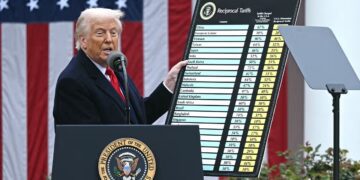By John F. Di Leo -
As schoolchildren, we were told “Thank Heaven for the First Amendment!” Our free press ensures that we know what’s going on, and guarantees that we can make informed choices on Election Day.
It’s a wonderful idea… but is it really possible? Was it ever, really?
Let’s consider just a few stories now in the news, and how they are being reported by reputable sources in the mainstream media… issues like the border wall, the Supreme Court, and the government shutdown.
The Border Wall Issue
One side says there’s no wall, another side says there’s already enough of a wall. Generally speaking, the majority of Americans want a wall on our southern border, while the Democratic party politicians are almost in lockstep opposing one. What’s the truth of it?
Well, in a 2000 mile border, there are already a couple hundred miles of various types of fencing, of various quality (the ones that can easily be tunneled under or climbed over are clearly insufficient for the purpose). Over half the border is a river, so a wall would not be appropriate for that stretch, but obviously there should be something… and part of the border is mountainous, which doesn’t make walls impossible (consider the Great Wall of China, for example), but does make it a bit more challenging.
The press, along with many politicians, present it as if we have an unguarded 2000 mile stretch, all of which needs a huge wall. In fact, we need various approaches to address the topography of the different sections.
Let’s consider a fresh news item: on Monday, January 14, one of the largest groups of asylum seekers ever apprehended at the US-Mexico border – 376 people – tunneled under the wall near San Luis, Arizona and happily surrendered to the waiting federal agents, to ask for asylum. ABC’s detailed news report talked about how 179 of them were children, including over 30 unaccompanied minors (those traveling alone but under 18 years of age). The report also shared the statistic that over 80% of those apprehended on the border nowadays are families with children… counting the unaccompanied minors, that becomes 87%.
But let’s look more carefully at those statistics. They’re presenting the number of people apprehended, and the piece gives the impression that this is likely the typical illegal alien population… but is it really? It’s only natural that people carrying small children would move more slowly and be more likely to be caught. Common sense tells us that in all likelihood, families get caught and individuals get through, but there is a common narrative to present, and if you select the right data, you can present only one side of the situation without being accused of being untruthful.
Let’s consider another problem with these statistics. What is a child, and what is a minor, in this context? We Americans think of anyone under 18 to be a child. It’s legal to refer to a teen as a child, so the reporters aren’t doing anything wrong in giving that impression. But in poor areas of the world, particularly in the communities that flood our southern border, teenagers are often on their own much before 18. Which context is the right one for us to consider, as we read such statistics? Without knowing whether we’re talking about parents carrying their 7-year-olds, or individual 17-year-olds who’ve probably already been on their own for two or three or four years now, the distinction between children and adults in all these statistics is meaningless… and perhaps even misleading.
In reading this article, a number of things should jump out at the critical reader: are these really family units, or 30-year-olds pairing up with 16-year-olds to present themselves as families for PR purposes? How useless are the existing fences, if people can so easily tunnel under them? How do uneducated indigents from all over central and south America manage to make it all the way to our southern border without help, and how do they know which technical regulations in US immigration law to claim, in order to present themselves as asylum-deserving refugees? Does this story convince us that the effort to close the border is hopeless, or more critical than ever, or does it divert our minds toward other humanitarian concerns so we forget about the wall entirely, and focus on the need of the people?
But do we think of these things as we read? Does every reader – and every voter – read between the lines and critically analyze the news presented, or are we so overwhelmed by the sheer volume of news that we take it at face value and move on?
The Supreme Court
The Supreme Court is deeply divided. We hear all the time how split it is, with four general originalists, four general expansionists, and one moderate serving as the Chief Justice. So all America is focused on the health of the 85-year-old Ruth Bader Ginsburg, as she suffers from various cancers and the other typical maladies of her age. With both she and Steven Breyer being over 80, the likelihood of President Trump getting two more appointments in his presidency has the Left absolutely beside themselves.
So the press keeps up a rather squirm-inducing deathwatch for Justice Ginsburg. The Left alternates between cursing her for not retiring during the Obama presidency and praising her for her voting record, while praying that she can somehow hold out another year, because if she retires or dies during 2020, the seat will likely remain unfilled until 2021.
The media reports on her condition raise different questions, but questions just as important. The press reports that “no further cancer was found” and “no further treatment is required.” The spin in this case is that she’s doing fine, and she’ll be right as rain soon, happily working from home for the time being, back in the Court building sometime in the next few weeks or months.
What they fail to say is whether they mean “no further cancer was found” because they looked, and there isn’t any, or if “no further cancer was found” because they didn’t look anywhere other than this one section of the lung. And why is no further treatment scheduled – because none is needed, or because none would help, because she’s beyond treatment? Once cancer gets in the lungs, it often spreads. She’s already had multiple kinds of cancer; at this point, as an 85-year-old with her medical history, it defies credibility to think it won’t return.
But again, the press accounts write narrowly, so that what they say is defensible. It’s the reader’s job to ask additional questions, to notice what’s left unsaid, to consider more beyond the scope of the article itself. In journalism school, students are told that people won't read the whole piece if it's long, so they are trained to cut, cut, cut. If you wonder why articles don't always have all the details you want, it's not always bias; sometimes it's because brevity is a sacrament in J-school.
We have another question to consider, too: while she works from home, should she be allowed to vote and write opinions, remotely? The reliance of Supreme Court Justices on their law clerks is legendary, and there’s nothing wrong with it, as far as that goes… but when the decision is made, we need to know that the final decision was made by the Justice, not by a clerk.
If the Justice is writing from home, what certainty do we have that the Justice made the final call on each of these choices? Every Supreme Court ruling affects tens of thousands, maybe even millions, of American citizens and businesses. Squeamishness about such things has no place here. Justices cannot be allowed to give their proxy to fellow Justices or to their law clerks.
Every American needs to remember one of the truly dark spots in American history. In 1919, President Woodrow Wilson suffered a terribly debilitating stroke, and his new wife, Edith Bolling Wilson, essentially took over for President Wilson for much of the final year and a half of his presidency. The official line at the time was that he was so fragile, she peacefully brought him all the issues, and brought back all his answers and directions, essentially as a personal secretary. But the truth – as it came out later – was that she took on the role of president herself, utterly unconstitutionally.
We should have no problem with Justice Ginsburg taking as much time as she needs to recuperate, or to decide whether or not to retire… America has had 8 justices before, and survived. But we do indeed have a public interest if she does vote, in ensuring that it’s truly Justice Ginsburg doing the voting. And that’s an issue that gets precious little coverage these days.
If the news consumer – the voter – is unfamiliar with the story of Edith Bolling Wilson, then the thought might never arise in the reader’s mind. Is this a fault of the press, or of an education system that too rarely covers such critical aspects of American history when preparing our students for their lives in a republican system?
The Current Shutdown
A four trillion dollar federal budget is currently stymied – to hear them tell it – because of a five billion dollar budget item for the aforementioned wall. President Trump, for his part, has come down from earlier estimates of around $25 billion, as his administration has considered such possibilities as concrete walls, steel fences, electronic surveillance, and other mixtures to meet the need at the lowest cost possible. The new Democrat leadership of the House is adamant against any further construction, despite the hundreds of thousands of illegal aliens who cross our border every year, and the 20 million plus estimates of total illegals already here.
Here the problem with the news stories is more fundamental. Everywhere we look, from newspapers to online journalism, from radio to television, we see that the shutdown boils down to one element of intransigence on both sides: the administration won’t budge unless the budget provides billions for the wall, and Speaker Pelosi won’t consider any budget with any wall funding whatsoever.
But even this is a bit of spin, true though it looks, because of two things commonly left out by the major media:
First, while five billion dollars sounds like an immense amount of money (and it is!), it is miniscule in the big picture of a four trillion dollar budget. We’re talking about a tenth of a percent here. It’s less than a rounding error. The Democrats oppose it because they want the flow of illegal immigration to continue (they vote Democrat), and they accept the flow of diseases, drugs, and other criminality that comes with it as unavoidable collateral damage. The budget item can’t possibly be the holdup, because their caucus votes for five billion dollar expenditures all the time. There’s no fiscal responsibility at the heart of their objection, however they may pretend.
But perhaps more important to the politics surrounding it: this is all a lie. The claim that the negotiations are at an impasse is proven untrue by a fact staring us in the face: how can negotiations be at an impasse if negotiations aren’t even going on?
President Trump has remained in Washington, and has tried to hold discussions constantly since before the beginning of the shutdown.
By contrast, Speaker Pelosi sent the House home at Christmastime (she herself went on vacation to Hawaii)… she led a House delegation on a party trip to Puerto Rico a week after New Year’s… and she attempted to take her leadership team on a round-the-world junket this week, with planned stops in Afghanistan, Egypt, and Belgium (until the administration had enough and cancelled their expected free military transport).
Which of the two sides is serious about negotiating, and which of the two sides is doing everything they possibly can to ensure that the shutdown lasts longer?
You can’t negotiate if you’re not meeting.
But has the press presented it this way? One might argue not.
But then, should the press need to present it this way? Everything mentioned here is in the news; everything is public record. Are American viewers and readers putting it all together?
The Big Picture
Our Founding Fathers designed this country very carefully, with checks and balances all over the system, specifically to improve upon the historic improvements of the Old World. They were products of the Enlightenment – specifically, the British Enlightenment – and intended for the United States to be the culmination of Western Civilization and the Judaeo-Christian religious tradition. They knew that for the nation to prosper, it would need to retain those roots.
We complain today about yellow journalism – the media bias plain to the naked eye in so many stories, the spin presented by pundits and politicians. But the fact is, we have always had some of that spin. The newspapers of the 1790s were terribly partisan, with Federalist and Jeffersonian newspapers presenting outright fabrications that would never fly today.
The difference was that the readers of the 1790s expected the spin, and were prepared for it. Their education – not in government schools (which didn’t yet exist), but in a combination of parish schools, private tutors, and homeschooling – taught them how to read, how to study, how to analyze.
In the Founding era, voters were raised to know their history, both here and in Europe. They were raised to apply the classical logic of the Greeks when they studied an issue. They were trained to read between the lines, to look for what the reporter didn’t say, to hunt down what the politician stayed silent about. They were trained to think critically.
We can hope for better news coverage, and we can certainly be more selective in our choices of media outlets. But in the end, we can never hope to deliver on the promise of the Founding Fathers – as voters ourselves – until we return American education to its roots. We need to break away from the government school monopoly format of education, and return to the independent, Enlightenment-fostered approach that gave us the brilliant minds of our Founding Fathers.
We need again to teach children our history, and show them how to analyze a story to get at the truth. Until we do, we will remain a nation divided, held captive by half-stories and misleading statistics.
Copyright 2019 John F. Di Leo
John F. Di Leo is a Chicagoland-based writer, actor, trade compliance trainer and Customs broker with DTTS Trade Compliance Seminars. His columns are regularly found here in Illinois Review.
Don’t miss an article! Sign up for the free email notification service in the margin of this webpage!







